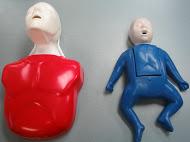Why should I study CPR?

The demand for CPR training programs have been on a steady increase as people are become more and more aware of the importance being trained in basic CPR. Disasters pop up left and right without warning, and having basic CPR training can mean the difference between life and death for a loved one or even a stranger. Cardiopulmonary resuscitation is used when the heart stops pumping blood effectively to the rest of the body, a condition called cardiac arrest. CPR is done by pressing hard on the chest and giving mouth-to-mouth rescue breaths. This helps the heart circulate oxygenated blood to the rest of the body and prevent major, potentially fatal damage.
What CPR training programs can I enrol in?
There are 5 CPR programs offered at San Francisco CPR. Four of these programs have accompanying re-certification training. The five programs are categorized under Basic Life Support (BLS) or Advanced Life Support (ALS). BLS programs teach trainees basic CPR skills such as compressions and rescue breaths, given to a victim before medical help arrives. ALS programs are much more complicated, teaching management of cardiac arrest in a clinical setting.
Basic Life Support
- Heartsaver CPR and AED is a general public program that includes CPR, AED, and first aid training. The program teaches single-person rescue over a single four-hour class. Basic first aid skills like the Heimlich maneuver, bandaging, and wound care are included in the program. To become certified, students can take a skills test at the end of training (optional).
- Heartsaver CPR and AED (C) is a healthcare provider program that is 4.5 hours long. It also teaches single-person CPR rescue along with first aid and CPR training. This program basically tailors the basic CPR class for the public for HCPs. The skills test and written test at the end of the program are mandatory.
- Basic Life Support for HCPs teaches trainees both 1-person and 2-person rescue, and introduces them to the 2010 BLS guidelines from the American Heart Association. The re-certification program is 4 hours long.
Advanced Life Support
All ALS programs require trainees to have a valid Basic Life Support for HCPs training certificate to qualify. A pre-test consisting of a practical and written test must also be passed by the trainee to qualify for training. All ALS programs also have a post-test skills and written exam to get certified.
- Advanced Cardiac Life Support (ACLS) is an HCP program that is 16 hours long and competed over 2 days. It teaches trainees how to manage cardiac arrest of an adult patient in a clinical setting. The program teaches trainees how to use bag valve masks and to assist in the insertion of endotracheal tubes. Basic pharmacology with adult dosages and indications are also part of the program.
- Pediatric Advanced Life Support (PALS) also runs for two days, taking 14 hours in total. While ACLS managed adult victims, PALS is responsible for pediatric patients – people younger than 18 years old. CPR for infants and younger children is very different from adult CPR. Pediatric assessment and pharmacology is an important part of the coursework for PALS.
